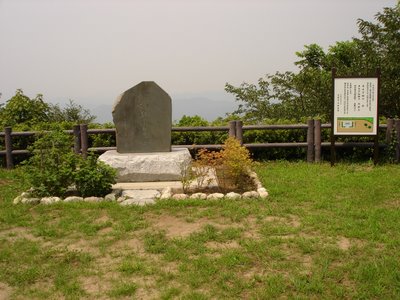On the west peak is a viewing platform built for a visit by Crown Prince Naruhito and Crown Princesss Masako, back in the days when they used to ostentatiously climb mountains surrounded by phalanxes of bodyguards, local officials and members of the press.

Beside the viewing platform is a stone monument commemorating the Crown Prince and Princess' visit. Beside the monument is a metal sign repeating the inscription carved into stone and--honest to Amaterasu--a map showing where one can find the monument.

Atop the east peak, the scene is a bit different.
A pitted and tilting sandstone staircase (not paying enough attention, I fell on the way back down) leads to a gateway...where no gate stands. Plinth stones give testimony to the temple entrance that had once stood there.

Entering the overgrown courtyard, inhabited only by giant dancing flitting black swallowtail butterflies, one's progress impeded by waist-high undergrowth.
One reaches the decrepit remains of the main hall. Through the open and decaying doors, one sees an empty altar. On the floor are a black and white line drawing of Kannon (Avalokiteshvara), leaves and blown-in dirt.

Nothing stirs.
The deities are gone.
* * *
You cannot miss them.
Once you leave the core urban areas you find them.
Terraced paddy fields choked with weeds;
crumpling houses;
trucks left in place so long their tires have dissolved;
restaurants that never open;
padlocked storefronts with kicked-in shutters, their interiors awash with seas of bottles and cans.
Not the mark of poverty is this. It is the mark of death.
Great areas of the land are dying, emptying out, rotting out like uncared for teeth, even in the prosperous Kantō plain.
And beyond the confines of the Kantō, the Nagoya Plain, and the Kansai corridor and the Fukuoka-Kokura industrial zone—Amaterasu help us.
* * *
I will have to dig around for the quote--but a few years ago a politician said something on the order of:
“It's so sad. Out in the countryside with the shuttered commercials districts (shattā gai)...and when it's festival time, there is nobody around, there is no festival spirit. It just gives of a feeling of lonesomeness.”
Yes, that is it. With the collapse of the business districts and the departure of the people come the end of the mandates and rituals of the kami. The twilight of the gods.
* * *
Long, long ago, the responsibility to protect every single square centimeter of Japan was parceled out to three classes of protectors. Two corporeal; one spiritual.
Over the long years these beings have jealous guarded the frontiers of their territories --while in benevolence laboring to bring prosperity to the residents within.
The names of these guardians?
Seijika, kōmuin, kami/hotokesama.
The Politicians, the Civil Servants and the Spirits.
Exalted they were. Respected. Spoken to in reverential, formal language.
The Politicians and the Civil Servants brought the roads and tunnels and bridges and tetrapods. They brought the subsidies and the regulatory mazes. The Greenpia and the third sector projects.
All to protect the residents and their livelihoods from change. To keep the world at bay. To protect their sacred precincts and prerogatives.
But change happened anyway.
The roads and bridges and tunnels made it easier for residents to drive to the formerly distant hypermarkets. No more was it necessary to patronize the little shops along the road leading out of the train stations.
By their budget allocations and zaitō investments, the myriad contracts to grateful construction firms, the Politicians made the countryside ugly. By their rules, requirements and regulations, the Civil Servants made it uniformly ugly.
With their subsidies and fiscal follies, they created a class of clients, persons incapable of creating value, engaging in activities that had no meaning.
They kept people living where people should not be...and wounded the land in the process.
So great was the damage done that at long last all that remained were the clients, the cavernous and empty great projects and the constipated fields, plantations and harbors. Most of the living had moved to the cities, leaving behind rituals and gestures, the pantomime of politics and bureaucratic budget slicing competitions.
* * *
I would love to hear the complaints of the kami, to hear them whine about decline in donations at festival time, the shorter and shorter lists of names hammered onto the signboard, the declining number of visitors throughout the year, the increasing age of the parishioners...
I wonder if the kami would at last declaim to me:
"It's because of the Western ways...the blasphemous worship of the deities from across the sea...the ancient harmony is ruined."
The kami have an excuse: they cannot move. They are bound to protect the same piece of land--their sacred territory with its invisible boundaries--even as the generations go by. Even as their shrines fall into ruin and the shoulders carrying the mikoshi grow fewer and more stooped.
Protectors of arbitrary and artificial divisions...to the end.
Redistricting...such a small thing to get wrong.

A lovely post; one of the best I've read from you, or from anyone else in the blogsphere for that matter.
ReplyDeleteOnce again, so very happy that you're out there blogging again.
may I respectfully suggest that you submit this post for publication by Asia Review ( full name?), or other magazines of stature. Or New York Times...
ReplyDeleteIt is that good
Ochka